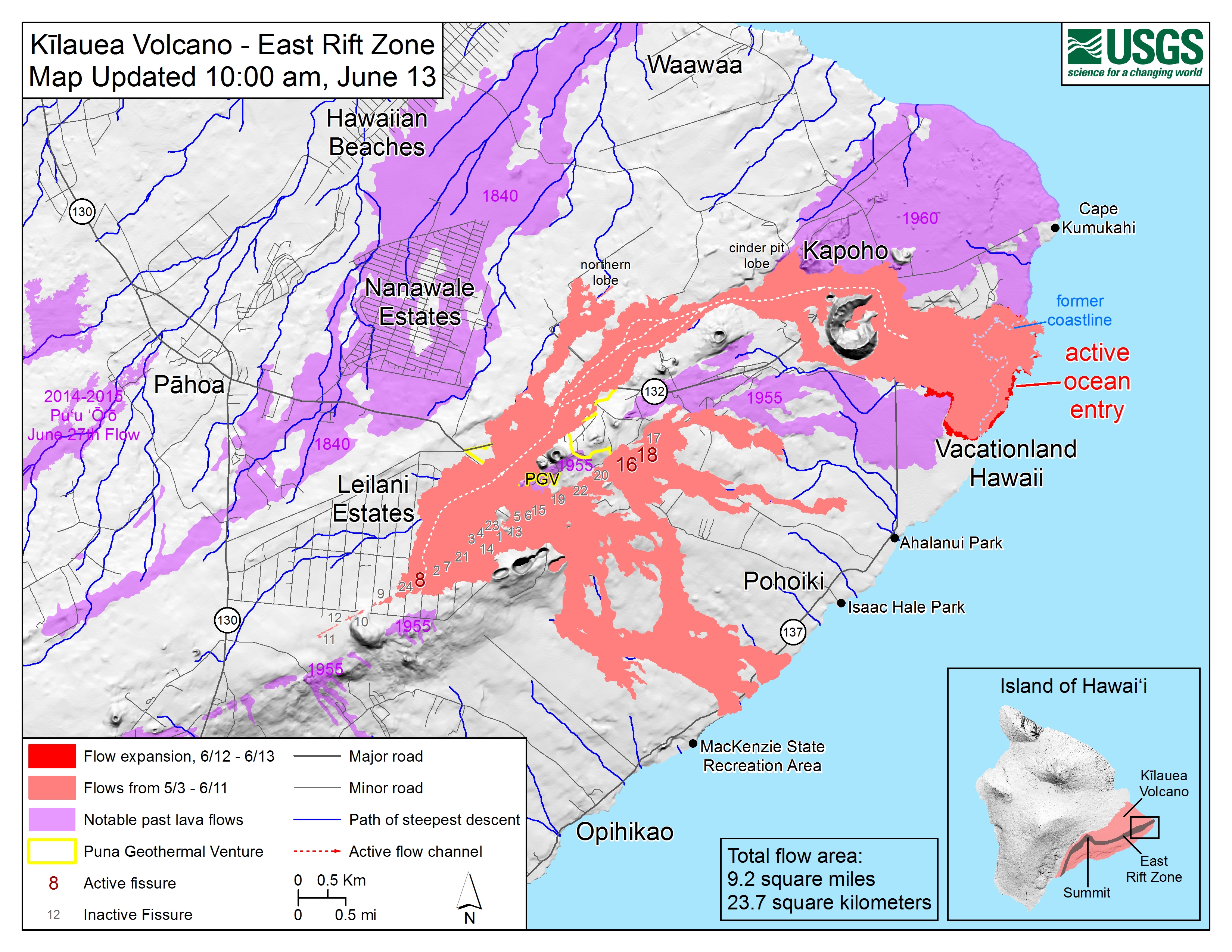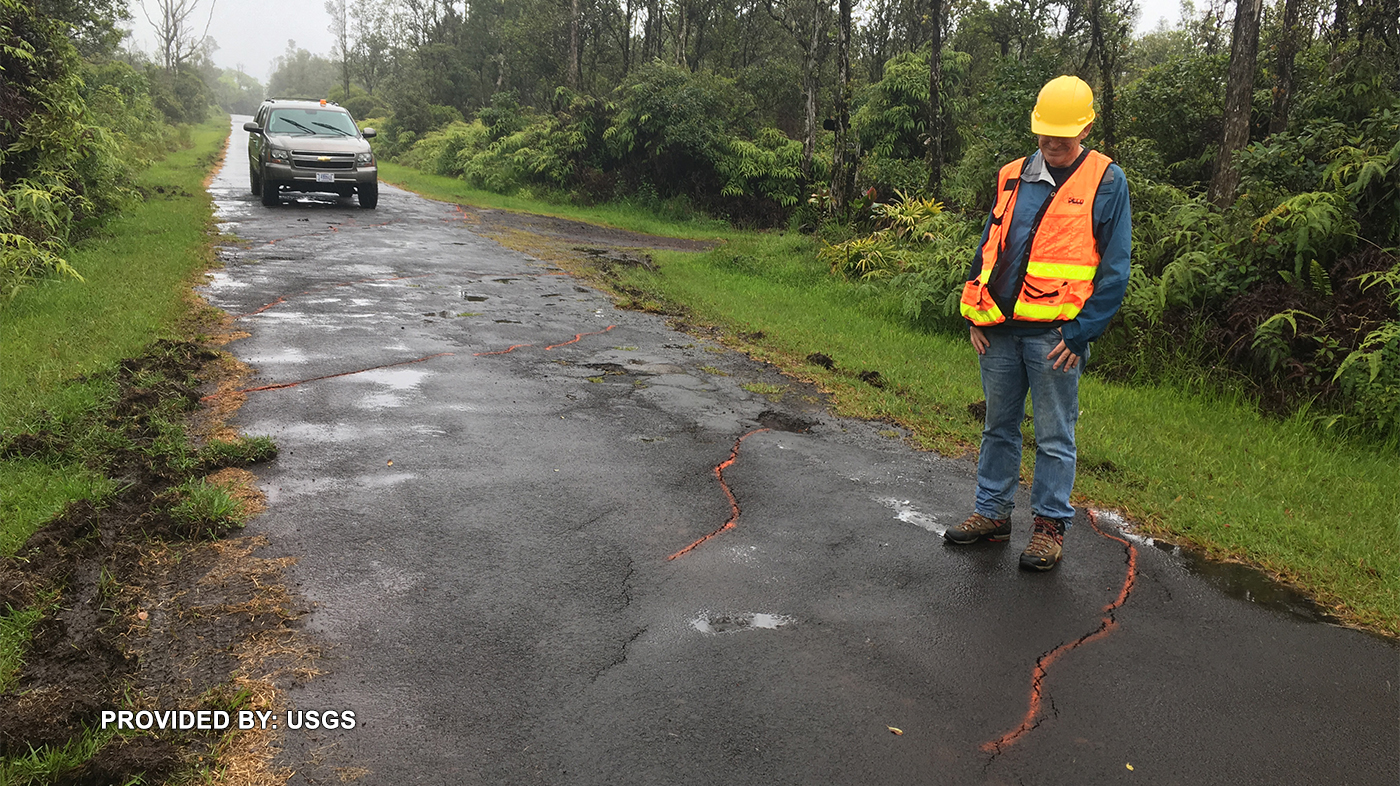Eruption of lava continues from the lower East Rift Zone fissure system in the area of Leilani Estates.
Lava fountains from fissure 8 reached heights of 200 ft overnight. The cinder and spatter cone that is building around the fissure is now about 165 ft at its highest point.
Lava is flowing through the well-established channel from fissure 8 to the ocean at Kapoho. The ocean entry remained fairly broad with laze blown onshore. Occasionally, lava spills over the channel levees.
Fissures 16 and 18 continue to ooze lava.
Seismicity increased overnight, climbing to about 40 events per hour with up to 5 magnitude-3+ earthquakes per hour. Many of these earthquakes were felt in the Volcano area.
Inward slumping of the rim and walls of Halema`uma`u continues in response to ongoing subsidence at the summit.
Sulfur dioxide emissions from the volcano’s summit have dropped to levels that are about half those measured prior to the onset of the current episode of eruptive activity. This gas and minor amounts of ash are being transported downwind, with small bursts of ash and gas accompanying intermittent explosive activity.
A reminder that N-95 masks that were distributed are for ash or vog particulate and will NOT protect from gasses or vapors, including SO2.
You can monitor sulfur dioxide and hydrogen sulfide on Hawaii Island by visiting the Civil Defense website or go directly to www.epa.gov/kilaueaairdata.
The mandatory evacuation order continues for all areas of Leilani Estates, at Pomaikai Street and to the east. The curfew has been lifted west of Pomaikai and is open only to residents with official credentials.
Government Beach Road, between Kahakai Boulevard and Cinder Road, is open to Waa Waa and Papaya Farms Road only to residents with official credentials. There is no curfew.
If you have been displaced, please fill out a Universal Intake Form at the Recovery Information and Assistance Center (RIAC) at the Pahoa Community Center, Monday thru Friday, 9 a.m to 3 p.m. This allows you to register as a disaster survivor so you can apply to receive assistance.
Pele’s hair and other lightweight volcanic glass from high fountaining of Fissure 8 are falling downwind of the fissure and accumulating on the ground within Leilani Estates. Winds may waft lighter particles to greater distances.
Residents are urged to minimize exposure to these volcanic particles, which can cause skin and eye irritation similar to volcanic ash.
The ocean entry at Kapoho Bay is a hazardous area. Hazards include walking on uneven, glassy lava flow surfaces and around unstable, vertical sea cliffs. Venturing too close to an ocean entry on land or the ocean exposes you to flying debris from sudden explosive interaction between lava and water.
Also, the lava delta is unstable because it is built on unconsolidated lava fragments and sand. This loose material can easily be eroded away by surf, causing the new land to become unsupported and slide into the sea.
In several instances, such collapses have also incorporated parts of the older sea cliff.
Additionally, the interaction of lava with the ocean creates laze, a corrosive seawater plume laden with hydrochloric acid and fine volcanic particles that can irritate the skin, eyes, and lungs.
Additional ground cracking and outbreaks of lava in the area of the active fissures are possible.
Residents close to any volcanic activity should remain alert and be prepared to voluntarily evacuate if necessary.
Take action to limit exposure to ash and volcanic gases by staying indoors or leaving the area. The Department of Health recommends limiting outside activities and stay indoors if you have breathing issues. If possible, close the windows and use your air conditioner.
Click here for an interactive map.
Related Story: Puna Geothermal Venture deemed stable after lava covers two wells
Because lava has entered the ocean, be aware of laze hazard and stay away from any ocean plume.
Laze is when hot lava hits the ocean sending hydrochloric acid and steam with fine glass particles into the air.
This hot, corrosive gas mixture caused two deaths immediately adjacent to the coastal entry point in 2000, when seawater washed across recent and active lava flows. Laze can cause skin and eye irritation and breathing difficulties.
Also be aware that the laze plume travels with the wind and can change direction without warning.
The Coast Guard is enforcing a Lava Entry Safety Zone for the navigable waters surrounding active lava flow entries extending 300 meters in all directions.

The Hawaii Department of Transportation is lowering the speed limit on Highway 130, between Leilani Estates and Kamaili Road, to 25 miles per hour. This is a safety measure for everyone who drives over the steel plates installed over cracks caused by volcanic activity.
The Fire Department and HVO will be actively monitoring the flows by helicopter.
Residents of these areas are reminded to protect yourself from ash fallout by remaining indoors or by using dust masks.
Related Story: People evacuated by helicopter from neighborhood isolated by fast-moving lava
Civil Defense gives the following tips if you are in an area affected by ashfall.
If you are at home, stay indoors with the windows closed. Turn on your radio and listen for updates from authorities.
If you are in your car, keep the windows closed. Ash fallout may cause poor driving conditions, due to limited visibility and slippery driving conditions. Drive with extreme caution, or pull over and park.
After the hazard has passed, do check your home, and especially your catchment system for any impact that may affect your water quality.
Here are some tips on what to do if your catchment system is impacted by ashfall.
Due to the toxic gas hazard in the affected area, the following are issued:
- Leaving the area of SO2 inundation is the best way to protect yourself and your family.
- Seek medical attention if severely affected.
Related Link: University of Hawaii’s Vog Measurement and Prediction Project
Related Story: How to protect yourself from sulfur dioxide in vog, acid rain

Earthquake activity and ground deformation continue and additional outbreaks in the general area of Leilani Estates are expected.
According to the U.S. Geological Survey’s Hawaiian Volcano Observatory, the East Rift Zone intrusion and seismic activity appears to be moving downrift in a northeast direction. Hazardous fumes continue to be released from existing cracks and fissures.
The location of future outbreaks can’t be predicted, but could include areas both uprift (southwest) and downrift (northeast) of the existing fissures, or resumption of activity at existing fissures. Communities downslope of these fissures could be at risk from lava inundation.
As a precautionary measure, residents of lower Puna, between Kapoho and Kalapana, are advised to be on the alert in the event of possible gas emissions and volcanic eruption. Because there may be little to no advance notice to evacuate, you should be prepared to evacuate at short notice. Take this time to prepare.
Related Story: National Guard plans for mass evacuations should more eruptions occur
If you evacuate voluntarily, the Pahoa Community Center and Keaau Community Center are open. Food will be provided and the shelters are pet-friendly. Click here for more information.
All beach parks in lower Puna have been closed, including the Pohoiki Boat Ramp.
Most of Hawaii Volcanoes National Park is now closed. Officials say it’s possible for a steam-induced explosion to occur at the summit of Kilauea Volcano due to the receding lava lake.
Should such an explosion occur, officials say the ensuing ash fall and southerly wind patterns would also create a public safety threat.
Related Story: Fear of steam-induced explosion prompts closure of Hawaii Volcanoes National Park
Related Story: Closures due to Kilauea Volcano’s latest eruption

Assistance for displaced residents
Leilani Estates residents will still be allowed to check on their property from 7 a.m. to 6 p.m. each day until further notice, conditions permitting. Residents will be required to provide identification and proof of residency in the subdivision.
A Recovery Information and Assistance Center (RIAC) will be open at Pahoa Community Center, Mondays through Fridays, 9 a.m. to 3 p.m. Residents can go there to register for entry placards if they wish to retrieve personal items.
“We’ve got to make sure we vet everybody as far as making sure that the actual residents or homeowners or renters are going in there and nothing else is happening,” said Magno.
Want to donate? How you can help families displaced by lava
The Hawaii County Police Department and the Prosecutor’s Office have established a policy of zero tolerance towards looting or vandalism. Under Emergency Provisions, any looting or vandalism will be treated as a felony.
Related Story: Pahoa man accused of looting several homes during lava-related evacuation
Officials urge all visitors to avoid the Leilani Estates area. Sightseeing is not allowed for safety reasons.
A Temporary Flight Restriction is in effect. All aviation requests are administered by the Hawaii Fire Department.

Residents reflect on disaster
- Why some decided to stay in Leilani Estates despite the dangers
- First-hand look as Leilani Estates resident returns home, retrieves belongings
- Single mother, teacher becomes one of dozens who lost home in lava outbreak
- Residents describe ‘devastating’ return after Kilauea’s lava claims dozens of homes
- Homes consumed by lava in Leilani Estates eruption, but most residents remain optimistic
